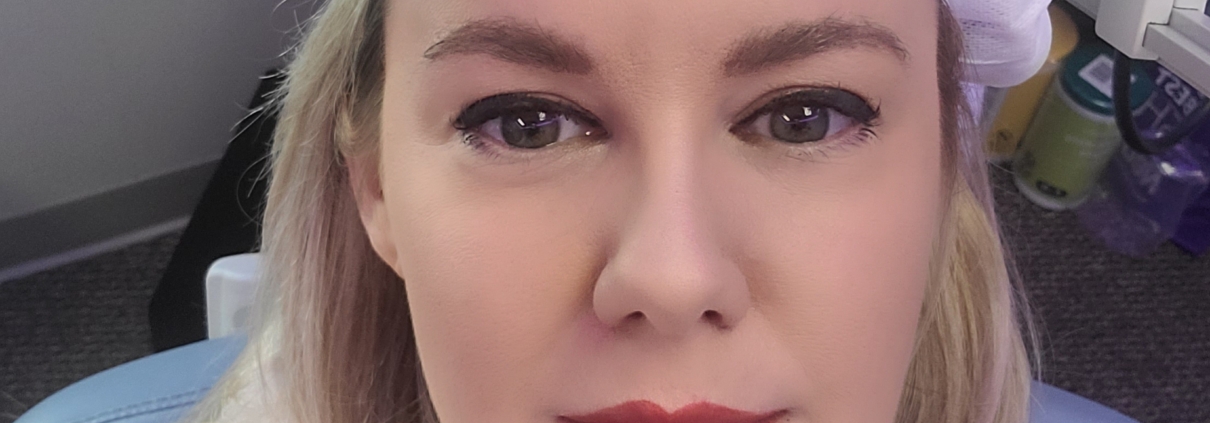My experience treating depression with magnetic waves
Editor’s note: Sandra Haney lives in Waynesboro, Virginia, and recently turned to Transcranial Magnetic Stimulation (TMS) to treat chronic depression. BrainWise Managing Editor Matt Villano wrote this story in her voice after an extensive interview with her about the experience. For more on the science of TMS, click here.
Depression is like an old friend at this point; I’m 41 years old, and I’ve been dealing with depressive episodes since I was about 15.
It was episodic early on. Things came and went. I had more prevalent anxiety than I did depression. Pretty severe panic attacks. Really frequent intrusive thoughts of death—not so much suicidal ideation but more thoughts about my eventual demise. Throughout my teens and twenties, I did therapy. I tried tons of different medications. Some worked a little. Most didn’t. There were a lot of side effects. I was about 28 when I found a combo of meds that worked: Paxil and Wellbutrin. I still had lots of side effects.
By the time I was 32, I said, “This is ridiculous.” I was tired all the time. I had gained about 30 pounds. Finally, I did a GeneSight test. It turned out I have a very rare triple copy of an enzyme called CYP2D6. That makes me an ultra-rapid metabolizer, which means roughly 80 percent of medications won’t work on me like they should. I metabolize them too quickly.
It’s not a great thing to have if you’re battling depression like I am.
When I learned about being an ultra-metabolizer, when I realized that meds basically weren’t going to work for me, I started thinking about Transcranial Magnetic Stimulation (TMS). From what providers had told me, this is a type of treatment that can work for people who can’t do meds—people like me. I didn’t know anybody who’d done it TMS. I did some research. I got a packet of literature. That was basically it—at the time, I was deeply depressed and could barely make it to my appointments, much less seriously consider something like that. So, I didn’t pursue it.
Fast-forward to 2022. I started sleeping extremely poorly. I was getting more and more depressed. I had a severe bout of anxiety that lasted for four months. As the anxiety subsided, I started experiencing suicidal ideation. It was becoming more and more severe. It reached a point where things were going south quickly. I talked to my psychiatrist. Together, we decided it was time to give TMS a try.
I started the treatment in August. I finished in October. All told, I did 37 sessions. And it helped. But more on that later.
Understanding the basics
When you get the treatment, a machine sends magnetic waves through your skull into your brain. The idea is to stimulate neurons to change the way they’ve handled things in the past—kind of like rewiring the brain. For more about the science behind it, check out the sidebar that BrainWise published in conjunction with my story.
My TMS sessions started out at 21 minutes long. By the end they were at 31 minutes. It’s kind of boring to sit there while the treatment is happening. The doctors told me I needed to stay fully conscious. They let me talk. There was a TV in the room so I could watch TV. They were clear that they wanted me to keep my brain active.
Every time I went it felt like an electric zap. Like a static shock. There was no sense of pain. It was like tapping against my head. This may just be my own imagination, but I could swear I felt it going through my skull. I know the brain has no pain receptors, so maybe that’s impossible.
During the sessions I didn’t really experience any kind of change in thought processes or perception. I also didn’t experience any emotional effects. Initially there were headaches and a sense of really deep fatigue. That lasted the first two weeks. After that the immediate effects were a little brightening. My mood improved a little bit each time. It wasn’t a long-term thing; I felt better for a little while, and as the day wanes, my mood dropped back down. For me, it was all about the cumulative effect.
Side effects
After 4 treatments I had some interesting effects occur. One night, after cooking an elaborate dinner, I was sitting on the couch and, suddenly, it felt like I could smell everything. It felt like my sense of smell had been dampened that whole time and, suddenly, it had come into focus. It was like until the TMS treatment, I was smelling things at about 25 percent of what they were. The super smell lasted for about an hour each time, and then things went back to baseline. They say a lot of your senses get dampened with depression. I now know that’s real.
Another thing that happened during treatment: I started experiencing these perception switches. I would go from one state of mind to another. The switches occurred every 15 to 30 minutes. The only way I can describe what it felt like was to compare it to when I did acid a few times and ate mushrooms as a kid. The perception shift you get when you’re under the influence of those chemicals—that’s what it felt like for me.
Later in the treatment cycle I started to get very irritable and very angry. I’d have these mini bouts of rage that would last for 30 seconds or so each time. That was disturbing. Everybody in the house was jumpy and avoiding me. The cats were like, “We’re out of here!” I was told by the lead TMS tech that that was a good sign, that my brain was creating new neural connections and that’s what was causing the irritation. Most people experience a depressive episode in the first three weeks, but some people experience anger. That was difficult to deal with.
The suicidal ideation faded in the first week and a half. It faded out quickly. I don’t know if that was what was happening in my brain—something the machine was doing—or if it was the fact that I was getting help and I was actively doing something to improve things. I was looking at living and improving my health and having hope instead of thinking about ending things. That alone was worth everything.
Charting progress
Over the course of my treatment, there were several markers I used to evaluate how it was going.
The first were the markers from the doctor’s notes. Every Friday I did one of the DSM questionnaires about depression and anxiety. The doctor kept those scores. Over the duration of the treatment, the doctor said my scores decreased depression-wise by about half and anxiety-wise by about a little more than half. The reduction in anxiety was the biggest thing I noticed. The other thing is that I found myself to be more motivated, more hopeful and a little more energized. The reduction in anxiety has been fantastic. Suicidal ideation disappearing has been fantastic. Depression has decreased, for sure. They said I would start sleeping better, but I didn’t. I’m a lifelong insomniac.
I have mixed emotions about this progress. I was hoping for more. At the same time, I know my expectations were unrealistically high and the whole time I fought to bring my expectations back to reality. I had to come to terms with the fact that this is something that will improve things so that I can further improve on my own. It’s like the treatment gave me a toehold so I could get moving in the right direction.
My doctor said things would continue to improve for about two months after the last treatment finished. I’ve also read that each TMS treatment cycle lasts about a year, and that after the year it really varies wildly. About a month later I’m still seeing improvement.
I also recognize that I’m lucky to have insurance. This treatment runs anywhere from $12,000 to $16,000. With my copay it was $980. This is what my specific insurance company and specific insurance plan required before approving TMS. I’m sure requirements are different from company to company, and even plan to plan within the same company.
After dealing with depression for most of my life, this feels like having a future. A lot of possibilities are now open that weren’t open before. My husband and I have been planning trips. We’re talking about going to Iceland and Finland. We talked about doing a bunch of different things. I feel much more excited and motivated to do that. I feel more excited to live.
Spreading the word
I kept a journal about my experiences. Once a week, I shared these journal entries with my friend list on Facebook. The entries were straightforward. Here’s what’s going on with me. Here’s what’s happening. Here’s what it’s been like. People were really interested. After my journal entries, I have been contacted by phone and through Facebook by people who are either interested in TMS for themselves or for loved ones.
I would recommend TMS. Even if TMS doesn’t work for someone at all, I encourage people to try something. Depression is not a way to live well, and it can end in your demise. For me, TMS felt like going to the moon, doing something totally unknown and super frightening. At first, I felt like I was being a coward, but now I see the opposite is true. I can recognize it as being brave. The stigma around mental health is decreasing, which means more people are talking to each other about depression. Hopefully that means more and more people will start talking about TMS to help.
This essay has been factchecked by members of NAN’s Publications Committee. For more about that process, click here.









